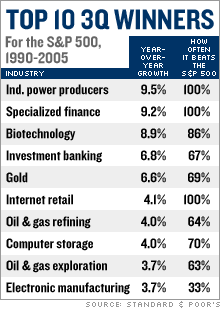|
Playing the stock market slowdown Investors are knee-deep in the toughest time of year for the markets. Here's a look at what sectors should hold up. NEW YORK (CNNMoney.com) -- Feeling sluggish lately? Don't just blame the heat wave. Summer's never an easy time for a stock investor, and this year is no exception. With the double whammy of the always tough third quarter and the potential economic slowdown, investors have their work cut out for them.
Since peaking in early May, stock markets have been all over the place on a mix of worries - both national and international - and the short-term outlook remains foggy. "Summer is typically not a great period," said Paul Levine, president at money manager Lifetime Financial Services. Indeed August and September are traditionally the worst months of the year for stocks, what with low attendance, less money moving in and out of the market, and the tendency for corporations and analysts to see the mid-year as the time to revise full-year profit forecasts. "Plus you have the confluence of rising rates, rising energy prices, the events in the Middle East, the consumer getting squeezed, the decline in the housing sector and the effects of the four-year presidential cycle," Levine added. The cycle, tracked by Stock Trader's Almanac, Standard & Poor's and other market researchers, suggests that the stock market often follows the four-year cycle of a presidential term, with year two - such as 2006 - the weakest of the four. Grace Fey, who manages large-cap portfolios at Frontier Capital Management, says that the stock market's biggest problem now and likely through the summer is "the interest rate issue." After 17 straight hikes since June 2004, the Fed funds rate, an overnight bank lending rate, currently stands at 5.25 percent, up from a level of 1 percent two years ago. Many traders and market watchers expect the central bank to boost rates again at the Aug. 8 meeting and perhaps beyond. "After more than two years, we're obviously closer to the end of the cycle than the beginning, but we need to get through the cycle before the market can really get better," Fey said. At this point in the cycle, more rate increases are "putting pressure on earnings multiples and calling into question the economic growth," Fey said, all of which sets up fears for investors of an environment that would be even tougher for stocks. But when the going gets tough, investors can often look to gold, bonds, and select alleged 'safe-haven' areas of the market. This summer isn't likely to be much different, the analysts said. Hedging against inflation, a slowdown "Over the next three months, gold and bonds will outperform stocks," said Daniel Turov, editor of market newsletter Turov on Timing. "In my largest managed accounts, I am 100 percent invested in the long-bond and gold mining funds, rather than stocks." Levine likes these areas too, but said that if one does want to be in stocks or stock funds, there are places to go. He's looking at healthcare and other defensive sectors. "You want to stick with companies that are going to continue to produce double-digit earnings growth and that won't get hurt too hard by a slowdown," Fey said. Fey said she would continue avoiding economically-sensitive areas of the market like Dow stock 3M, or the broad transportation sector, which has been getting clobbered lately. It's also common sense to go light on companies that have had huge cyclical runs, she said, such as chemicals and commodities - excluding energy. All of these sectors have run up sharply in the 3-1/2 year bull market, and have been struggling since then. Since 1990, energy has been the S&P 500's best performing sector in the third quarter, according to research compiled by S&P's chief market strategist Sam Stovall. The overall energy sector has been good for a gain of 1.8 percent, on average. Utilities is the only other broad sector besides energy to average a positive return during the third quarter over the last 15 years, according to Standard & Poor's. Among the smaller industry groups, biotechnology, gold and select financial areas have done well. (For details on the third quarter's best industry performers, see the graphic.) "Utilities aren't cheap, but they do have the dividend yield, the earnings stability and the benefit from high oil prices," said Jack Ablin, chief investment officer at Harris Private Bank. Ablin said that healthcare and consumer staples are also areas that have a good price-to-earnings ratio relative to the broader market, because they haven't been doing that well this year, but are now showing signs of improving. However, Fey said that investors need to be careful with consumer stocks as some of the ones she owns in her portfolio - including Procter & Gamble (Charts) and Pepsi (Charts) - may be classic defensive plays but aren't really that attractively valued in terms of price-to-earnings. She's more interested in select financial services stocks such as Bank of America (Charts) and Northern Trust (Charts). In addition, playing it safe doesn't mean you have to play it boring. "I think you have to look at the non-economically sensitive areas of the market, but still look for a good risk versus reward ratio," said Manny Weintraub, money manager at Integre Advisors, a firm specializing in high net-worth investors. He said that within that universe of stocks, he's looking for the currently out-of-favor stocks that look like they could turn around. Favorites of his include medical device maker Boston Scientific (Charts) and contact-lens manufacturer The Cooper Companies (Charts). -- Portfolio managers contacted for this story own shares of the companies they discussed. |
|




